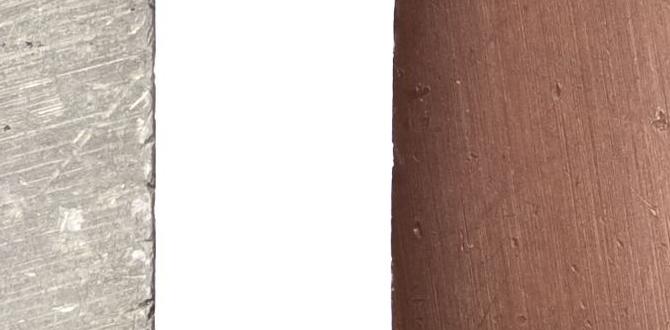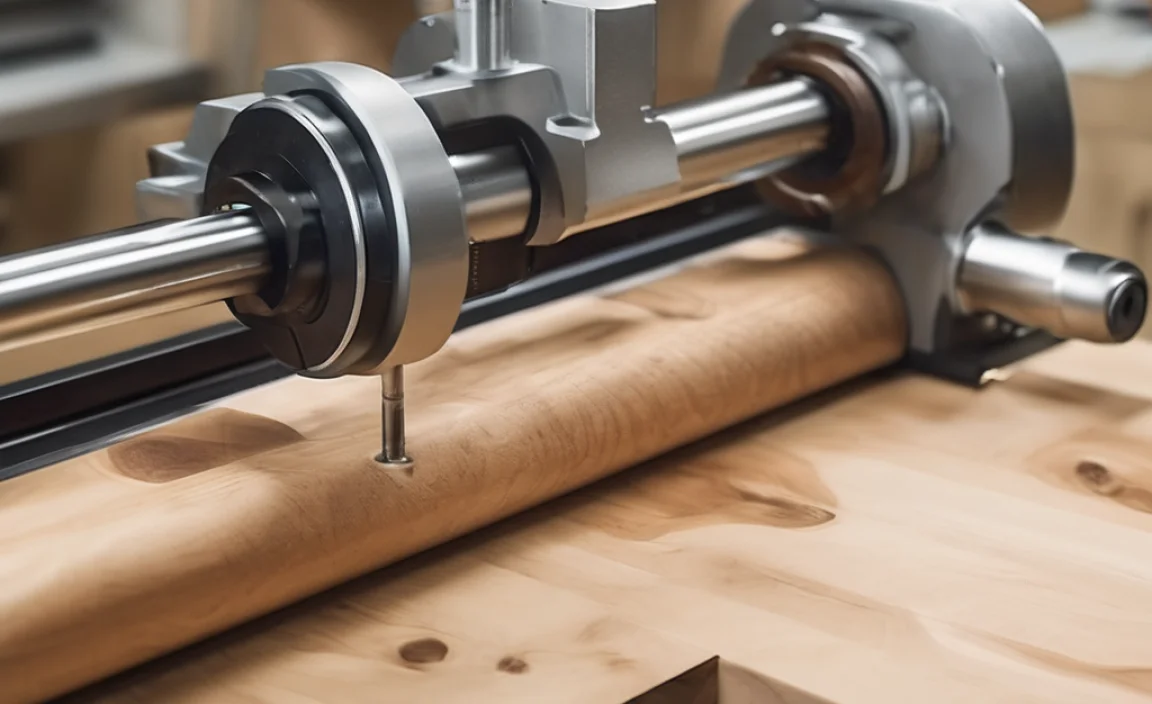Quick Summary
The 35-degree TiAlN ball nose end mill is a workhorse for roughing many materials, including PVC. Its Titanium Aluminum Nitride coating and unique angle provide durability, heat resistance, and efficient material removal, making it a smart choice for initial shaping in your projects.
Hey there, fellow makers and tinkerers! Daniel Bates here from Lathe Hub. Ever stared at a block of material, unsure of the best way to start shaping it, especially for preliminary cuts? It can feel a bit daunting, right? Especially when you’re diving into materials like plastic, aluminum, or even softer steels. You want a tool that bites in, removes material reliably, and doesn’t cost a fortune or break the bank. That’s where the humble yet mighty TiAlN ball nose end mill with a 35-degree helix angle comes in. It’s a fantastic, versatile tool for getting the bulk of your roughing done efficiently. Stick with me, and we’ll walk through exactly how this tool can become your go-to for those crucial first steps in your milling projects.
Understanding the TiAlN Ball Nose End Mill 35 Degree for Roughing
When you’re starting out in milling, the sheer variety of cutting tools can be overwhelming. Let’s break down what makes a TiAlN ball nose end mill with a 35-degree helix angle so useful, especially for roughing operations. Think of roughing as the initial shaping stage – removing large amounts of material quickly to get close to your final desired form. It’s not about precision; it’s about efficiency and getting the basic shape down.
What’s in the Name?
Let’s decode this seemingly complex name:
- Ball Nose: This refers to the shape of the cutting tip. It’s perfectly rounded, like a ball. This shape is excellent for creating curved surfaces, fillets, and pockets without sharp internal corners. For roughing, it can leave a nicer surface finish than a square end mill, even at this initial stage.
- End Mill: This is the general classification of the tool. It’s designed to cut on its periphery and often on its end, allowing for plunging (cutting downwards) and side milling.
- TiAlN (Titanium Aluminum Nitride): This is a special coating applied to the surface of the end mill. It’s a hard, thin layer that dramatically improves the tool’s performance.
- 35 Degree Helix Angle: This is a crucial angle related to the flutes (the spiral cutting edges) of the end mill. A 35-degree helix angle offers a good balance between aggressive material removal and a smooth cutting action.
Why TiAlN Coating Matters
The TiAlN coating is like armor for your end mill. It provides several key benefits:
- Increased Hardness: Makes the tool resistant to wear, so it stays sharp for longer.
- High-Temperature Resistance: Milling can generate a lot of heat. This coating allows the tool to maintain its hardness even at elevated temperatures, preventing it from softening and dulling quickly. This is especially important for roughing where you’re removing a lot of material rapidly.
- Reduced Friction: The smooth coating helps chips flow away more easily and reduces the friction between the tool and the workpiece.
- Corrosion Resistance: Protects the end mill from rust and chemical attack.
The Role of the 35-Degree Helix Angle
The helix angle dictates how the cutting edge engages with the material. Most general-purpose end mills have a 30-degree helix angle. A 35-degree angle offers some subtle advantages for roughing:
- Smoother Cutting Action: It tends to provide a slightly smoother cut, reducing vibration and chatter compared to very steep or very shallow helix angles. This means less stress on your machine and a generally better surface finish, even during roughing.
- Good Chip Evacuation: The angle helps to curl and eject chips effectively. Good chip evacuation is vital during roughing to prevent chip recutting and tool breakage.
- Versatility: While optimized for certain materials, a 35-degree angle remains versatile enough for various common materials you’ll encounter in a hobbyist or beginner setting.
Applications: Where the 35-Degree TiAlN Ball Nose Excels
This specific type of end mill is a fantastic all-rounder for roughing, meaning it’s suitable for a broad range of materials. For beginners, having a tool that can handle multiple jobs with confidence is a huge plus. Let’s look at where it shines:
Metals: Plastics and Beyond
While we’re highlighting PVC, it’s important to know this tool isn’t limited to just plastics. It’s a great starting point for softer metals too:
- Plastics (like PVC, ABS, Acrylic): These materials are generally easier to machine. A TiAlN coated end mill will cut through them cleanly, with the coating helping to prevent melting and sticking. The ball nose is perfect for creating rounded edges or hollows.
- Aluminum Alloys: This is another common material for DIY projects. The 35-degree helix angle with TiAlN coating performs well, resisting the tendency of aluminum to load up (stick to) the cutting edges.
- Brass and Copper: Similar to aluminum, these softer yellow metals machine well with this type of end mill.
- Softer Steels: For mild steel or lower-carbon steels, this end mill can be used for roughing, especially if you’re not pushing the limits. The TiAlN coating provides the necessary wear resistance.
Woodworking with a Twist
While dedicated wood carving bits exist, a ball nose end mill can be surprisingly useful for certain woodworking tasks, especially if you’re working with harder woods on a CNC router where you want a durable, coated tool:
- Carving and Engraving: For detailed 2D or 3D carving in wood, especially if you’re looking to add rounded recesses or contours.
- Molding and Panel Making: Creating decorative edges or shaping panels.
It’s worth noting that for typical woodworking with a manual milling machine, you might opt for less aggressive, uncoated tools, but for CNC work or working with very dense exotic woods, a coated end mill like this can extend tool life.
Key Advantages for Roughing Operations
When your primary goal is to remove material quickly and efficiently, the 35-degree TiAlN ball nose end mill offers distinct advantages for roughing:
Efficiency and Speed
The combination of the TiAlN coating and the helix angle allows for higher feed rates and shallower depths of cut without sacrificing tool life. This means you can remove material faster, significantly reducing your machining time for the initial shaping of a part. This is the core benefit of a roughing end mill.
Durability and Tool Life
The TiAlN coating is incredibly hard and wear-resistant. This means the tool will maintain its cutting edge for much longer, especially when compared to uncoated tools, even when subjected to the stresses of roughing. This translates to less frequent tool changes and a more consistent machining process.
Heat Management
Roughing generates a lot of heat. The TiAlN coating’s ability to withstand high temperatures prevents the cutting edge from softening. This is crucial for preventing tool failure, melting of softer materials like plastics, and maintaining a more predictable cutting process.
Improved Surface Finish
While the primary goal of roughing isn’t a mirror finish, a good roughing tool should leave a surface that’s manageable for subsequent finishing passes. The ball nose shape and the 35-degree helix angle contribute to a smoother chip formation and evacuation, often resulting in a better-than-expected surface finish for a roughing operation.
Versatility
As mentioned, this end mill is a great all-rounder. For a beginner or a home workshop, having one reliable roughing tool that can handle a variety of common materials is incredibly practical and cost-effective.
Getting Started: Practical Steps for Using Your 35-Degree TiAlN Ball Nose End Mill
Now that you know why this tool is great, let’s get hands-on with how to use it effectively and safely. Remember, safety first! Always wear appropriate personal protective equipment (PPE), including safety glasses, and ensure your workpiece is securely clamped.
Step 1: Machine Setup
Ensure your milling machine is stable and clean.
- Secure the Workpiece: This is paramount. Use clamps, vises, or fixtures that are appropriate for your material and the forces involved. A loose workpiece is a serious safety hazard.
- Install the End Mill: Mount the end mill securely in your collet or tool holder in the spindle. Ensure it’s seated correctly to avoid runout (wobble).
- Check Spindle Speed: The correct spindle speed (RPM) is crucial. For roughing with a TiAlN coated end mill, a moderate to high speed is often appropriate, depending on the material. Consult your machine and tool manufacturer’s recommendations. A good starting point for aluminum might be 5000-10000 RPM. For plastics like PVC, you might run slightly slower to prevent melting.
Step 2: Setting Your Cutting Parameters
This is where you define how the end mill will cut. For roughing, you’ll typically use:
- Depth of Cut (DOC): This is how deep the end mill cuts into the material with each pass. For roughing, you can take fairly aggressive cuts, but you should never exceed about half the tool’s diameter in depth for a single pass, and often less is more. A common recommendation for roughing is a DOC of 0.1 to 0.5 times the tool diameter, depending on rigidity and material.
- Stepover (Radial Depth of Cut): This is how much the tool moves sideways with each pass when clearing out an area. For roughing, a stepover of 40% to 70% of the tool diameter is common to maximize material removal rate.
- Feed Rate: This is how fast the tool moves through the material. It’s often expressed in inches per minute (IPM) or millimeters per minute (mm/min). Higher feed rates can be used for roughing, but they must be balanced with spindle speed and depth of cut. Too high a feed rate can overload the tool or machine.
Important Note: These are general guidelines. Always refer to feeds and speeds calculators or manufacturer recommendations for your specific tool and material. Tools like the Machining Doctor app or online calculators can be very helpful: Machining Doctor provides a good starting point for material-specific calculations.
Step 3: Machining Passes
Begin your roughing operation.
- Plunging: If you need to cut downwards into the material, do so carefully. Some end mills are designed for ‘chipless plunging’ (like some specialized ones), but for standard end mills, it’s best to spiral plunge (moving in a circular path downwards) or plunge at a shallow angle if possible, especially in harder materials. For softer materials like PVC, straight plunging is often acceptable but still proceed with caution.
- Contouring/Pocketing: Move the end mill across the material as per your programmed toolpath. For roughing, you’re aiming to remove the bulk of the material defining your shape.
- Cooling/Lubrication: For metals like aluminum, using a coolant or cutting fluid is highly recommended. It helps to cool the tool and workpiece, lubricate the cut, and flush away chips. For plastics like PVC, air cooling or no lubricant is often preferred to avoid making a mess or melting the plastic into gummy chips.
Step 4: Inspect and Refine
After your roughing passes, stop the machine and inspect your work.
- Check Dimensions: Are you getting close to your desired shape?
- Assess Surface Finish: Is the surface reasonably smooth for a roughing pass?
- Tool Condition: Check the end mill for any signs of excessive wear, chipping, or melting.
Based on your inspection, you might make adjustments to your cutting parameters for subsequent passes or for your finishing tool. For very aggressive roughing, you’ll often leave a small amount of material (e.g., 0.010″ to 0.020″) for a finishing pass with a sharper, potentially different type of end mill to achieve a high-quality surface.
Choosing the Right Size and Variations
The “35 Degree TiAlN Ball Nose End Mill” is a category, but the exact tool you choose will depend on your specific project needs.
- Diameter: End mills come in a vast range of diameters, from tiny fractions of an inch to several inches. For roughing, larger diameters can remove material more aggressively, but you need to ensure your machine can handle the forces and that the diameter fits your intended geometry. Always consider the capabilities of your milling machine.
- Number of Flutes: This refers to the number of cutting edges on the tool. While traditional end mills might have 2 or 4 flutes, specialized ‘high-performance’ roughing end mills often have more flutes (6 or even 8) and a ‘chip breaker’ geometry. However, for general beginner roughing across various materials, a 4-flute design is a very common and versatile choice. End mills with fewer flutes (like 2) are often better for softer materials like plastics and aluminum as they provide better chip clearance and can be run at higher speeds.
- Length of Cut: This is how far up the end mill the flutes extend. Ensure the length of cut is sufficient for your project depth.
Troubleshooting Common Issues
Even with a great tool, you might run into snags. Here are a few common problems and how to address them:
Excessive Vibration or Chattering
This is frustrating and can lead to poor surface finish and tool breakage.
- Causes: Loose workpiece, dull tool, incorrect cutting speeds/feeds, machine rigidity issues, too deep a cut.
- Solutions: Ensure workpiece is clamped securely. Try a slightly shallower depth of cut or a lower feed rate. Check spindle speed and adjust if necessary. Make sure your tool holder is clean and the end mill is seated correctly. For some materials, a tool with a different helix angle (e.g., 30 degrees) might be smoother.
Tool Breakage
This is expensive and can be dangerous.
- Causes: Too aggressive a cut (depth or feed), inadequate chip clearance leading to chip recutting, plunging too fast, dull tool, weak clamping, entry into a hard spot in the material.
- Solutions: Reduce depth of cut and feed rate. Ensure good chip evacuation, especially in deep pockets. Use appropriate plunging techniques. Replace dull tools promptly. Double-check workpiece clamping.
Melting or Burning (especially in Plastics)
This is a common issue with softer materials.
- Causes: Excessive heat generated due to friction, insufficient cooling, cutting too slowly, or too much material engagement.
- Solutions: Increase spindle speed if possible (but be mindful of chip load). Decrease feed rate or depth of cut. Use air blast for cooling. For some plastics, a tool with fewer flutes (like 2) and sharper geometry can help. Ensure chip evacuation is efficient to carry heat away.
Poor Surface Finish
Even for roughing, you want a usable surface.
- Causes: Dull tool, incorrect cutting parameters, vibration, poor chip evacuation.
- Solutions: Sharpen or replace the end mill. Adjust speeds and feeds – sometimes a slightly higher feed rate combined with a moderate depth of cut can improve finish. Ensure your machine is rigid and the workpiece is secure. Clean out flutes if chips are building up. Consider if a finishing pass is needed.
Comparison Table: TiAlN Ball Nose vs. Other Roughing Tools
To further solidify why the 35-degree TiAlN ball nose is a good beginner choice, let’s compare it to a couple of other common roughing options:
| Feature | 35 Degree TiAlN Ball Nose End Mill | Uncoated Square End Mill (e.g., 4-flute) | Carbide Roughing End Mill (e.g., Serrated) |
|---|---|---|---|
| Primary Use | General roughing, curved surfaces, pockets. Good for plastics, aluminum, softer steels. | General-purpose milling, slotting, facing, edge profiling. Good for softer materials before finishing. | Aggressive roughing, high material removal rates in harder metals. |
| Coating | TiAlN (Heat & wear resistant
|








